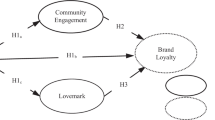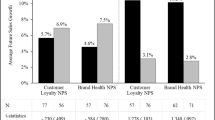Abstract
Independent bookstores (often called “indies” or “independents”) sustained threats to their basic business model because of the growth of national bookstore chains and the proliferation of book sales online, in price clubs, supermarkets, convenience stores, mass merchants, and specialty stores, the emergence of digital e-books and eReaders, and the U.S. recession of 2007–2009. These events triggered the closing of hundreds of independent bookstores. In spite of stiff online and brick-and-mortar competition and the recession, many independents were able to grow in size and importance. This article outlines the competitive advantages utilized by many independent bookstores between 2009 and 2018, resulting in an increase in the number of independent bookstores between 2009 (1651) and 2018 (2470).
Similar content being viewed by others
References
Tebbel J. A history of hook publishing in the United States: volume I The creation of an industry 1630–1865. New York: R.R. Bowker; 1972, p. 91, 109–110, 112–115, 119.
Novak S. A brief history of the Moravian Book Shop: among the oldest bookstores in the world. https://www.lehighvalleylive.com/bethlehem/2018/05/a_brief_history_of_the_moravia.html.
Tebbel J. A history of hook publishing in the United States: Volume II The expansion of an industry 1865–1919 (New York: R.R. Bowker, 1975), p. 10, 13–14, 16, 68, 100, 104, 113, 152, 293–294, 483, 565, 574.
Tebbel J. A history of hook publishing in the United States: Volume III The golden age between two world wars 1920–1940 (New York: R.R. Bowker, 1978), p. 53, 55, 396–397, 403–405, 467–468, 498. Highland KD.
Cheney OH. Economic survey of the book industry, 1930–1931. New York: R.R. Bowker; 1960. p. 16–103.
Radway JA. A feeling for books: the book-of-the-month club, literary taste, and middle-class desire. Chapel Hill: University of North Carolina Press; 1997. p. 21–84.
Miller LJ. Reluctant capitalists: bookselling and the culture of consumption (Chicago: University of Chicago Press, 2006), p. 45.
Tebbel J. A history of book publishing in the United States: Volume IV The Great Change 1940–1980 (New York: R.R. Bowker, 1981), p. 6, 16, 25, 28, 36, 42, 46, 54, 59, 66, 88, 94, 108, 338–339, 377, 398, 483, 622, 664, 722, 736.
Milliot J. Tracking 20 years of bookstore chains. https://www.publishersweekly.com/pw/by-topic/industry-news/bookselling/article/48473-tracking-20-years-of-bookstore-chains.html.
History of Barnes & Noble. http://www.barnesandnobleinc.com/about-bn/heritage/#entry-0.
Greco AN. The economics of the publishing and information industries: the search for yield in a disintermediated world (New York: Routledge, 2015), p. 196–197, 199–200.
Wilson M. Chain store age, report: online sales. https://www.chainstoreage.com/technology/report-online-sales-will-reach-645-billion-in-2020-but-growth-slowing/.
Wasserman S. The Amazon effect. https://www.thenation.com/article/amazon-effect.
Milliot J. Industry sales dipped in 2018, Pub Weekly, July 1, 2019, p. 3.
National Bureau of Economic Research. U.S. Business Cycle Expansions and Contractions. https://www.nber.org/clcles.html.
Rich R. The Great recession: December 2007–June 2009, Fed Res Hist. https://www.federalreservehistory.org/essays/great_recession_of_200709.
U.S. Department of Labor, Monthly Labor Report, Consumer spending and unemployment from 2007–2009 recession through 2022. https://www.bls.gov/opub/mir/2014/article/consdumer-spending-and-us-emplopyment-from-the=recession-through-2022.htm.
Baron NS. Words onscreen: the fate of reading in a digital world. New York: Oxford University Press; 2015. p. x.
Jallat F, Capek MJ. Disintermediation in question: new economy, new networks, new middlemen. Bus Horiz. 2001;44(2):55–60.
For the number of U.S. bookstores, see The Bowker Annual and the Library and Book Trade Almanac; various years. For U.S. annual bookstore revenues, see U.S. Department of Commerce, Bureau of the Census. https://www.census.gov/retail/index.html.
Federal Reserve Bank of New York, Current Issues in Economics and Finance. Why small businesses were hit harder by the recent recession. https://www.newyorkfed.org/medialibrary/media/research/current_issues/ci17-4.pdf.
Bosman J. Novelist fights the tide by opening a bookstore. https://www.nytimes.com/2011/11/16/us/ann-patchett-bucks-booksopre-tide-opening-her-own.html. Bosman wrote that “The American Booksellers Association, a trade group, currently [in 2011] has about 1,900 independent bookstores as members, down from about 2,400 in 2002.” There were 1,822 independent bookstores in 2011.
American Booksellers Association. https://www.bookweb.org.
The American Booksellers Association. “Opening a Bookstore”. https://www.bookweb.org/membership/openingabookstore; “Developing a Business Plan,” https://www.bookweb.org/developing=business-plan. ABA worked with Paz & Associates: “Prepare to Own a Bookstore, http://pazbookbiz.com; and “Selling or Buying a Bookstore”. http://pazbookbiz.com/services/selling-your-bookstore.
American Booksellers Association, ABACUS. https://www.bookweb.org/professional-bookselling/abacus.
BTW: Bookselling This Week. https://www.bookweb.org/news.
BTW: Bookselling This Week. https://www.bookweb.org/news/learn-about-principles-bookstore-finance-now-108567.
BTW: Bookselling This Week. https://www.bookweb.org/news.
American Booksellers Association. Selling books online: Ecommerce solutions for independent bookstores. https://www.bookweb.org/eCommerce.
Ibid.
Porter, ME. Competitive strategy: techniques for analyzing industries and competitors (New York: The Free Press, 1998), p. 12–49.
Porter ME. The competitive advantage: creating and sustaining superior performance. New York: Free Press; 1985. p. 45–78.
Greco AN. Economics of publishing in The Oxford handbook of publishing, Phillips A and Bhaskar M, editors. Oxford: Oxford University Press; 2019. p. 165–188.
Greco AN. The strategy of publishing in The Oxford handbook of publishing, Phillips A and Bhaskar M, editors. Oxford: Oxford University Press; 2019, p. 189–206.
Slater J, Deschamps, M. College accounting, 14th edn. Upper Saddle River: Prentice Hall; 2019. p. 1–77, 89–102.
Underhill P. Why we buy: the science of shopping, p. 11–12, 21–22, 126–128.
Koschmann A, Isaac MS. Retailer categorization: how store-format price image influences expected prices and consumer choices. J Retail. 2018;94(4):364–79.
Kim J. The impact of different price promotions on customer retention. J Retail Consum Serv. 2019;46(1):95–102.
Grewal D, Roggeveen AL, Nordfalt J. The future of retailing. J Retail 2017, 93(1): 1–6, 168–231.
Mowrey CH. Retail facility design considering product exposure. https://corescholar.libraries.wright.edu/etd_all/1575 (2016).
Foster A, Ford N. Serendipity and information seeking: an empirical study. J Doc. 2003;59(3):321–40. https://doi.org/10.1108/002204103104725183/4.
Thomas L. Store closures accelerate and may top 12,000 in 2019. Here’s what closed so far this year. https://www.cnbc.com/2019/07/13/retail-store-closures-in-2019-freds-charming-charlie-and-more.html.
Cheng A. Bookstores find growth as ‘anchors of authority’. https://www.nytimnes.com/2019/06/23/business/indepdndent-bookstores,html?searchResultPositiomn=1.
Dain A. Guess what’s anchoring many small downtowns? Even in the age of online shopping, the answer is: bookstores. https://commonwealthmagazine.org/economy/guess-whats-anchoring-many-small-downtowns.
Osnos, P. How ‘indie’ bookstores survived (and thrived). https://www.theatlantic.com/business/archive/2013/12/how-indie-bookstores-survived-and-thrived/281974.
Winfree J, Watson P. Does “buying local” help communities or conflict with basic economics? https://blog.oup.com/2017/07/buying-local-communities-economics.
Maynard M. Cookbook sales are jumping, which is great news for shops that specialize in them. https://www.forbes.com/sites/michelinemaynard/2019/03/10/cookbook-sales-are-jumping-which-is-great-news-for-shops-that-specialize-in-them/#1a51bc716e54.
Rosen J. The next wave of children’s bookstores. https://www.publishersweekly.copm/pw/by-topic/childrens/childrens-industry-news/article/75591-the-next-wave-of-children-s-bookstores.html.
Ogilvy D. Ogilvy on advertising. New York: Atheneum; 1964. p. 32–54.
Underhill P. The call of the mall. New York: Simon & Schuster; 2004, p. 69, 127, 192–3.
Yan J. Bookstores in Peoria are not just about books. https://www.pjstar.com/entertainmentlife/20190714/bookstores-in-peoria-are-not-just-about-books.
Wilson K. How a local bookstore can make your town richer—in more than one way. https://www.strongtowns.org/journal/2019/1/8/local-bookstores.
Kusito L. A decade after the housing bust, the exurbs are back. https://www.wsj.com/articles/a-decade-after-the-housing-bust-the-exurbs-are-back-11553610771?mod=article_inline.
Bauerlein, V. American suburbs swell again as a new generation escapes the city. https://www.wsj.com/articles/american-suburbs-swell-again-as-a-new-generation-escapes-the-city-11561992889?mod=hp_lead_pos7.
United States Bureau of the Census, Fastest growing cities primarily in the South and West. https://www.census.gov/newsroom/press-releases/2019/subcountry-population-estimates.html?mod=article_inline.
Rosenwald MS. In the age of Amazon, used bookstores are making an unlikely comeback. http://www.courant.com/business/hc-wapo-used-books-20151228-story.html.
Willis H. Downsizing the American dream: The new trend toward ‘missing middle housing’. https://www.washingtonpost.com/realestate/downsizing-the-american-dream-the-new-trend-toward-missing-middle-housing/2019/02/13/0f6d0568-232b-11e9-81fd-b7b05d5bed90_story.html?noredirect=on&utm_term=.3e2586df2f76.
Malito A. More Americans want to downsize their homes than supersize them. https://www.marketwatch.com/story/more-americans-want-to-downsize-their-homes-than-supersize-them-2017-03-01.
Kachka B, Stein JD. 6 independent bookstores that are thriving—and how they do it. https://www.nymag.com/intelligencer/2014/04/6-nyc-independent-bookstpres-that-are=thriving.html.
CBS News. Once-endangered bookstores are booming again. https://www.cbsnews.com/news/once-endangered-bookstores-are-booming-again..
The Financial Accounting Standards Board. The Financial Accounting Standards Board (FASB) is the independent, private-sector, not-for-profit organization… that establishes financial accounting and reporting standards for public and private companies and not-for-profit organizations that follow Generally Accepted Accounting Principles (GAAP). https://www.fasb.org/facts.
St. John A. Book chain sends out community SOS, Wall St J, July 14, 2019, p. A11A.
U.S. Department of Labor, Bureau of Labor Statistics. Seasonally adjusted, “Employment and Earnings Online”. www.bls.gov/opub/ee/home.htm.
U.S. Department of Labor, Bureau of Labor Statistics. https://www.bls.gov/cpi/tables/supplemental-files/historical-cpi-u-201903.pdf.
The Board of Governors of the Federal Reserve System (U.S.). https://fred.stlouisfed.org/series/M1.
U.S. Department of Commerce, Bureau of Economic Analysis (BEA),National Income and Product Accounts Tables: Table 1.1.5. Nominal GDP, Table 1.1.1. GDP Growth Rate. Table 1.1.6. https://www.bea.gov/data/gdp/gross-domestic-product.
U.S. Department of Commerce, Bureau of Economic Analysis, National Income and Product Accounts Tables, “Table 7.1. Selected Per Capita Product and Income Series in Current and Chained Dollars”. http://www.bea.gov/iTable/index_nipa.cfm.
U.S. Department of Commerce. U.S. Census Bureau. https://www.census.gov/programs-surveys/poppro/data/tables.html.
Cheng, A. Bookstores find growth as ‘anchors of authenticity. https://www.nytimes.com/2019/06/23/business/independent-bookstores.html?searchResultPosition=1.
Nawotka, E. Indies see 2018 sales jump 5% with ABA adding 95 stores. https://www.publishersweekly.com/pw/by-topic/industry-news/bookselling/article/79027-sales-at-indies-up-5-in-2018-as-aba-adds-95-stores.html.
Green A. Booksellers announce first annual bookstore romance day. https://www.publishersweekly.com/pw/by-topic/industry-news/bookselling/article/79671/booksellers-announce-first-annual-bookstore-romance-day.html.
Abraham M Van Kerckhove JF, Archacki R, Esteve Gongalez J, Fanfarillo S. The next level of personalization in retail. https://www.bcg.com/publications/2019/next-level-personalization-retail.aspx?utm_medium=Email&utm_source=esp&utm_campaign=none&utm_description=ealert&utm_topic=none&utm_geo=glb&utm_content=201907&utm_usertoken=5dda89f1e7e8e2fd2c8823ce1ddf1c3658bf91bd&redir=true.
Marx P. Wanna buy a book? https://www.newyorker.com/magazine/2008/06/02/wanna-buy-a-book.
Christensen, CM. The innovator’s dilemma: the revolutionary book that will change the way you do business. New York: Harper Business; 2011, p. xi–xxxi, 3–5, 6–8.
Greco A Milliot J. Don’t put tariffs on books, Pub Week, June 17, 2019, p. 72.
Samuelson P. The trillion dollar bet. https://www.pbs.org/wbgh/nova/transcripts/2704stockmarket.html.
CERN, the European Organization for Nuclear Research (Conseil Européen pour la Recherche Nucléaire). The Standard Model explains how the basic building blocks of matter interact, governed by four fundamental forces.
Author information
Authors and Affiliations
Corresponding author
Additional information
Publisher's Note
Springer Nature remains neutral with regard to jurisdictional claims in published maps and institutional affiliations.
Rights and permissions
About this article
Cite this article
Baidis, S., Greco, A.N., Kontolios, M.D. et al. Creating Competitive Advantage: The Growth of Independent Bookstores in the U.S. 2009–2018. Pub Res Q 35, 670–684 (2019). https://doi.org/10.1007/s12109-019-09678-0
Published:
Issue Date:
DOI: https://doi.org/10.1007/s12109-019-09678-0




